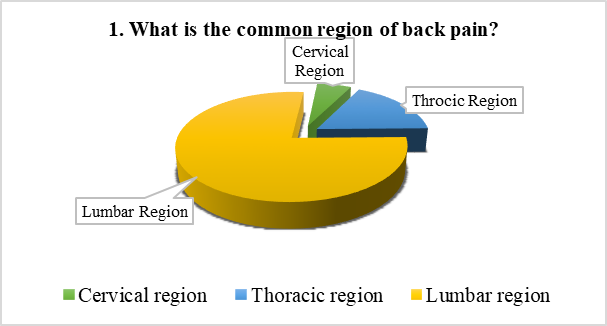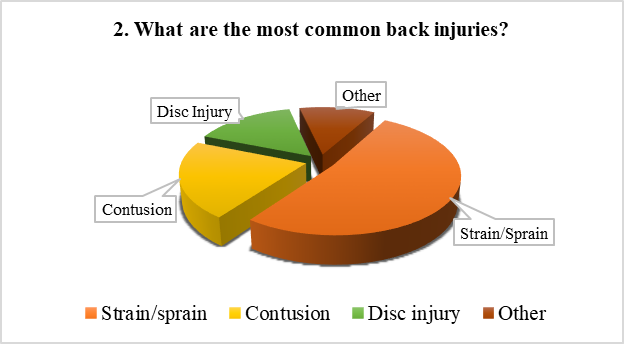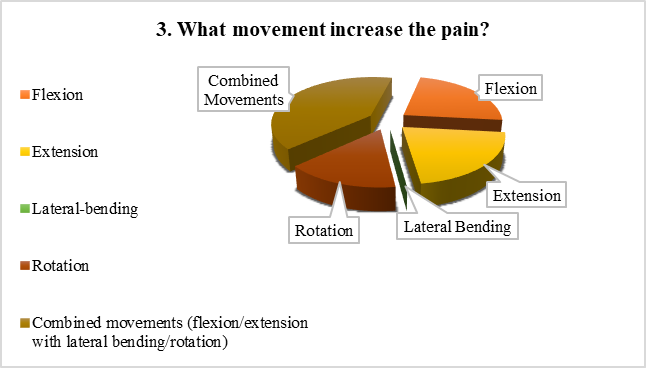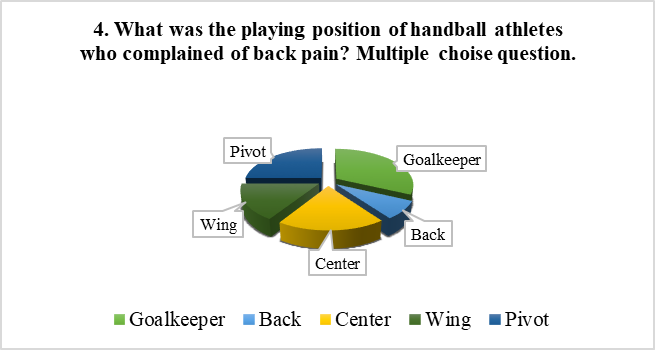Abstract
In handball, specific physical demands differ and indifference to spinal demands can cause a serious hindrance in infinite value of sport life. The main aim of this paper is to make steps toward understanding and identify clear patterns of spinal injury profile from handball players according to their playing positions. With these challenge in mind, a new method using a structured and specific questionnaire has been applied to a number of 52 senior male handball players. The study reveals that the lumbar region accounts the most vulnerable to spinal injury with most of the cases with a chief complaint of low back pain than may oscillate over time, with asymptomatic periods between recurrences. For instance, the prevalence of lower back pain suffers variations with playing positions but we notice that the goalkeeper player is submitted to a higher risk of back pain and this requires a special attention to his special technical and tactical training program. This topic can be a particular good challenge for physiotherapist which should use their strong knowledge of the anatomy and physiology of spinal region, recognizing epidemiologic patterns and implemented a structured and specific injury prevention approach from an early age to optimize the injury prevention process or recurrence.
Keywords: Handball, low back pain, physiotherapist
Introduction
Handball is a team sport characterized by a high intensity specific demands with physical contact between players, rapid and repeated changes of movement, high intensity running efforts, jumping and landings (Andersson, 2018). The broad literature that was completed to identify studies reporting on spinal injuries is lacking of knowledge regarding this subject, in handball players in particular. The results of spinal injury research are highly influences by dynamic and repetitive nature of sport, often resulting in lost playing and training time in professional players and, in severe cases, a persistent disorder can lead to the premature end of an athletes career (Mitchell et al., 2016). Various physical movements and practice styles specific to competitive sports, physically stress the lumbar vertebrae, in particular, and reflects a risk factor of developing different levels of lower back pain, with many diagnostic possibilities (Kaneoka, 2015).
Epidemiology of injury in handball
While the incidence of injuries to the spine may be relatively lower than other musculoskeletal in injuries, the consequence including time missed from these injuries can be significant. Epidemiological data of injuries in handball is lacking on the subject of back pain or back disorders and there is no exhaustive and prospective randomized studies specifically for handball players. A one-year prospective study reveals that the incidence rate of injuries during one season, in German handball players, was evaluated at 2.5 injuries per 1000 player-hours, with a higher incidence in game injuries (14.3 injuries per 1000 game-hours) compared with practice injuries (0.6 injuries per 1000 practice-hours) (Seil et al., 1998). Traumatic injuries were located on the knee (10 %), the fingers (9 %), the ankle (8 %), and the shoulder (7 %), and overuse injuries were located on the shoulder (19 %) and the low back (17 %). A prospective cohort study specifically for handball players shows that the injury incidence rate during training is 3.7/1000 and during matches is 20.3/1000 with a prevalence of lumbar spine injuries for traumatic events in 8% of the cases and overuse in 4% of the cases (Giroto et al., 2015). These results indicates that match injury incidence is significantly higher than training incidence.
Classifications of sports injuries
Sports injuries can occur for innumerable reasons such as poor preparation for activities undertaken, to inherent biomechanical problems, to over-enthusiastic training or a simply pure accident (Ward & Mitchell, 2016). The classifications of injuries differ and are dependent on the type of damage, mode of onset, mechanism, severity, location and by its causes. Basically, there are two causes of injuries: traumatic (macro-trauma) and overuse (micro-trauma). An injury occurs in a single acute episode (acute injury) or in a multiple episode (overuse injury) as a result of repetitive micro trauma to every anatomical structure of the neuromusculoskeletal system such as the bone, joint, tendon or muscle (Thoreux et al., 2016).
Problem Statement
The spinal region is a broad term to describe structures related to or situated near the spine and includes structures which comprise the spinal region such as the spinal cord and vertebral column. Another structural elements includes structures that support the spine, including skin, muscles, ligaments, fascia and vascular and neural tissue (Caseley & Johnson, 2016). While the above section highlights a general classifications of injury and the incidence that may place inherently the athletes at greater risk of spinal injury, it is also important to understand the various possible injury and the predisposing factors. In order to go ahead in is of interest to better understand the most common sports-related back injuries.
Specific spinal injury among athletes
In particular, due to the high impact loading and ongoing repetitive movement’s patters from competitive sports the athletes are more likely to experience specific low back pain than the general population (Mitchell et al., 2016). Almost 30% of athletes will experience low back pain at some point in their career and those with previous back injuries are three times greater risk for suffer another back injury that those who did not have a previous one (Glotzbecker & Hedequist, 2014). The most commonly prevalent back injury, in particular in young handball players, are low back pain, sprains and strains, disc-related back pain, spondylolysis, spondylolisthesis, stress fractures and atypical Scheuermann kyphosis (Rocha, 2018). There is an association between excessive exposure to competitive sports during youth and the incidence of both low back pain and low back disorders (Hangai, 2015). Senior players are exposed to spinal loads from an early age and it is suggested that more years in competitive sports led to a higher for back disorders rates (Kaneoka, 2015).
Risk factors for spinal injury
While back disorders are typically associated with patterns of spine loading combined with high speeds, repetitive movements like repetitive flexion, or hyperflexion, combined with lateral bending or rotation (Rocha, 2018) there are a large array of risk factors. The appearance of lumbar injuries and back pain include risk factors such as: improper technique, decreased range of motion, abrupt increases in training or poorly prepared athlete (Glotzbecker & Hedequist, 2014). Another factors that seems to contribute to the increase of spinal injury incidence is the high training volumes and intensities that immature spine structures of youth players undertake to achieve sporting performance (Donatelli & Thurner, 2014). In addition, these several factors linked to nature of sport combined with the spinal developmental process, that might be a secondary disadvantage to spinal injuries appearance, may also have long-term health consequence influencing handball player’scareer. Also, some favorable circumstances can usually be found and can be divided into intrinsic (refer to intrinsic characteristics of an athlete like age, gender, body composition, anatomy, health, fitness level such as muscle mass, strength, balance and neuromuscular control) and extrinsic (equipment and field conditions like floor friction in indoor team sports, protective equipment, environment) (Meeuwisse & Bahr, 2009). When risk factors act simultaneously, the athlete may be at far greater risk of injury than when risk factors are present in isolation.
Research Questions
To gain information on spinal injured anatomic parts a specific questionnaire was applied to a total of 52 senior male players. The questionnaire was applied during one competitive season, individually with each athlete. From the collected data it was possible to identify demographic characteristics such as team name, age, region, handball experience, training volume, player position, any injuries or surgery and information related to injuries. If players reported spinal injuries in their career, additional information was collected through the questionnaire, including details on anatomic region, pain intensity, facts related to the injury experience, components of injury assessment, factors affecting the injury experience, whether it occurred during a match / training any medical examination, injury mechanism and whether it was a recurrent injury, anatomical abnormality, their resilience to injury, their opinion of the importance of a physiotherapist on the team and the consistency of core training that have made during their carrier. The following graphs highlight the most relevant items extracted from the applied questionnaire.
The prevalence of players with conditions related to the spinal region was high, especially with the increasing injury placed upon the lumbar region. Low back pain was the most prevalent musculoskeletal complaints in handball players and accounts for up to 77%, the second most commonly affected was the thoracic region (17%), cervical region 6% (see Figure 1).

The pain rating scale used was Visual Analogue Scale with anchor statements on the left (no pain) and on the right (extreme pain). The majority of the players responded making a handwritten mark that represented that the pain was moderate pain (40%) and the severe pain (10%). From the moment that pain appeared, the severity of pain increased for (27%), oscillated over time (36%), remained the same for 33% and have improved for 4% of the players. The pain recurrence was reported by 83% of the players with asymptomatic periods between crises. The first time appearance of low back pain was reported during training for 37%, during matches for 42% and after training for 21% of handball players. Lumbar injuries were more specifically broken into strain/sprain injury (52%), contusion (21%), disc injury associated with shooting pain or paresthesia’s down the legs (15 %,), other (12%) (See Figure 2).

Another specific questions reveals from our observations than during training and matches the handball players are required to perform spinal movements that involve repetitive bending and twisting coupled with flexion/extension at high speeds. The incidence of pain is also affected by repetitive extension in 21% of cases, flexion in 23% of cases, rotation in 15% of cases or a combination of movements in 41% of cases (see Figure 3).

The players are resilient at pain and continue to play despite the pain discomfort in order to win the match (54%), check the self-overcoming potential (21%), technical team pressure (15%), not losing their place in the team (4%) or for their desire for affirmation (6%). This resilience reasons can also be a factor that impact on the potential occurrence of injury or a predictor of future back pain. Since each athlete position have different tasks and different physical demands and so on the injury incidence is different. The highest injury incidence is reported in goalkeepers (32%) and the pivot (25%) (See Figure 4).

Therefore, in order to prepare the players to perform at their maximum, it is of critical importance that core training to be adapted according there unique and specific technique. Regardless of that, 69% players considered that their core training during their carrer was poorly guided or practised and 73% players consider that the presence of a physiotherapist is essential to prepare themselves properly and recognize the possibility of symptoms that could be associated with underlying structural or developmental abnormality.
Purpose of the Study
The main aim of this paper was to identify the spinal injuries profile at handball players and underline the importance of a physiotherapist in implementation of specific preventive strategies according their specific spinal demands in each playing position.
Research Methods
The research methods was carried out as follows: method of study of specialized literature, method of analysis, method based on questionnaire adjusted for the specific context of spinal injuries, graphical and table method, statistical-mathematical method.
Findings
The prevalence of handball players with conditions related to the spinal region is high, especially in senior athletes with increased demands placed upon their spinal regions from an early age. In order to expand the current knowledge regarding the spine injuries in handball we underline that the lumbar region is particularly more susceptible in these patterns associated with persistent low back pain disorders. Low back pain is a symptom that can represent maladaptive changes with multiple diagnostic possibilities and we also underline that a previous low back pain without a personalised rehabilitation programme is a stronger predictor for a future low back pain. More often there is a correlation between the pain and a strain/sprain injuries, contusion or a disc injury. The incidence of low back pain is also affected by type of spinal demands and player position or performance. The goalkeepers appear to have risk factors for specific spinal injuries that may correlate with the asymmetrical loading and sudden changes of speed and repetitive demands based on their specific techniques. Given his knowledge in anatomy, biomechanics and kinematics of spine, a physiotherapist can influence athletes through guidance to prevent injuries, providing a spine safe strengthening and a safe performance environment. Whit respect for the coach, we emphasize that the absence of a physiotherapist in the team may be a predictor for future injuries. The injuries may be associated with another several factors, for instance: a poor trained core, repetitive demands with high loads on the spine, the spinal developmental process that have an influence on mechanics and associated injuries in the young athlete, athlete’s resilience to injuries or ignorance of the past clinical history of the athlete.
Conclusions
Since the literature is lacking on spinal injuries subject in handball players is difficult to establish a comprehensively and strengthened conclusion for this research. Spinal injuries are a common entity in handball players. Understanding the functional anatomy, biomechanics and kinematics of the mature adult spine and, in the first place, limitations of the paediatric spine which undergoes developmental changes is important to prevent spinal injuries. On the other hand, consideration of all relevant aspects that can contribute to spinal injuries in handball players, in the context of a multidisciplinary team environment which includes a physiotherapist, will prepare the athletes to adapt to demands of competition. Special attention should be paid to the relationship between specific pattern of spinal demands and playing position in handball players.
References
Andersson, S. H. (2018). Injury prevention in elite handball [Doctoral dissertation, Norwegian school of sport sciences]. Oslo Sports Trauma Research Center Archive. https://www.ostrc.no/globalassets/publications/phd-thesis/andersson_2018_phd-thesis.pdf
Caseley, J. A., & Johnson, M. I. (2016). The spinal region. In K. Ward (Ed.), Routledge Handbook of Sports Therapy, Injury Assessment and Rehabilitation (pp. 295-296). Routledge. https://b-ok.xyz/book/2860194/ab2e5c
Donatelli, R. A., & Thurner, M. S. (2014). The Young Athlete’s Spinal Mechanics. In L. Micheli, C. Stein, M. O’Brien, & P. d’Hemecourt (Eds.), Spinal Injuries and Conditions in Young Athletes (pp. 17-24). Springer-Verlag New York. https://b-ok.xyz/book/2296855/a3057d
Giroto, N., Hespanhol Junior, L. C., Gomes, M. R. C., & Lopes, A. D. (2015). Incidence and risk factors of injuries in Brazilian elite handball players: A prospective cohort study. Scandinavian Journal of Medicine & Science in Sports, 27(2), 195-202.
Glotzbecker, M. P., & Hedequist, D. J. (2014). Acute thoracic and Lumbar Injuries. In L. Micheli, C. Stein, M. O’Brien, & P. d’Hemecourt (Eds.), Spinal Injuries and Conditions in Young Athletes (pp. 27-35). Springer-Verlag New York. https://b-ok.xyz/book/2296855/a3057d
Hangai, M. (2015). The Epidemiology of Low Back Disorders in Athletes. In K. Kanosue, T. Ogawa, M. Fukano, & T. Fukubayashi (Eds.), Sports Injuries and Prevention (pp. 375-381). Springer Japan. https://b-ok.xyz/book/2679224/eec7ee
Kaneoka, K. (2015). Low Back Disorders Among Athletes and Its Prevention. In K. Kanosue, T. Ogawa, M. Fukano, & T. Fukubayashi (Eds.), Sports Injuries and Prevention (pp. 367-373). Springer Japan. https://b-ok.xyz/book/2679224/eec7ee
Meeuwisse, W., & Bahr, R. (2009). A systematic approach to sports injury prevention. In R. Bahr, & Engebretsen, L. (Eds.), Sports Injury Prevention (pp. 7-15). Wiley-Blackwell. https://b-ok.xyz/book/1094801/a05c9a
Mitchell, T., Burnett, A., & O’ Sullivan, P. (2016). The athletic spine. In D. Joyce, & D. Lewindon (Eds.), Sports injury prevention and rehabilitation: integrating medicine and science for performance solutions (pp. 289-303). Routledge. https://b-ok.xyz/book/2860117/2db2c6
Rocha, R. (2018). Back Injuries and Management of Low Back Pain in Handball. In L. Laver, P. Landreau, R. Seil, & N. Popovic (Eds.), Handball Sports Medicine (pp. 375-385). Springer Berlin Heidelberg. https://b-ok.xyz/book/3577226/3afdad
Seil, R., Rupp, S., Tempelhof, S., & Kohn, D. (1998). Sports injuries in team handball. A one-year prospective study of sixteen men’s senior teams of a superior nonprofessional level. The American Journal Sports Medicine, 26(5), 681-687.
Thoreux, P., Edouard, P., Marsaudon, A., & Rochaix, L. (2016). General Consideration on Sports-Related Injuries. In H. O. Mayr, & S. Zaffagnini (Eds.), Prevention of Injuries and Overuse in Sports (pp. 1-11).Springer-Verlag Berlin Heidelberg. https://b-ok.xyz/book/2678863/ef24b3
Ward, K., & Mitchell, A. (2016). Sports injuries: basic classifications, aetiology and pathophysiology.In K. Ward (Ed.), Routledge Handbook of Sports Therapy, Injury Assessment and Rehabilitation (pp. 1-4). Routledge. https://b-ok.xyz/book/2860194/ab2e5c
Copyright information

This work is licensed under a Creative Commons Attribution-NonCommercial-NoDerivatives 4.0 International License.
About this article
Publication Date
10 April 2023
Article Doi
eBook ISBN
978-1-80296-961-0
Publisher
European Publisher
Volume
5
Print ISBN (optional)
-
Edition Number
1st Edition
Pages
1-1463
Subjects
Education sciences, teacher education, curriculum development, educational policies and management
Cite this article as:
Cazac, G., & Georgescu, L. (2023). Spinal Injury Profile Of Senior Handball Players: A Study Of Questioning. In E. Soare, & C. Langa (Eds.), Education Facing Contemporary World Issues - EDU WORLD 2022, vol 5. European Proceedings of Educational Sciences (pp. 404-411). European Publisher. https://doi.org/10.15405/epes.23045.42

